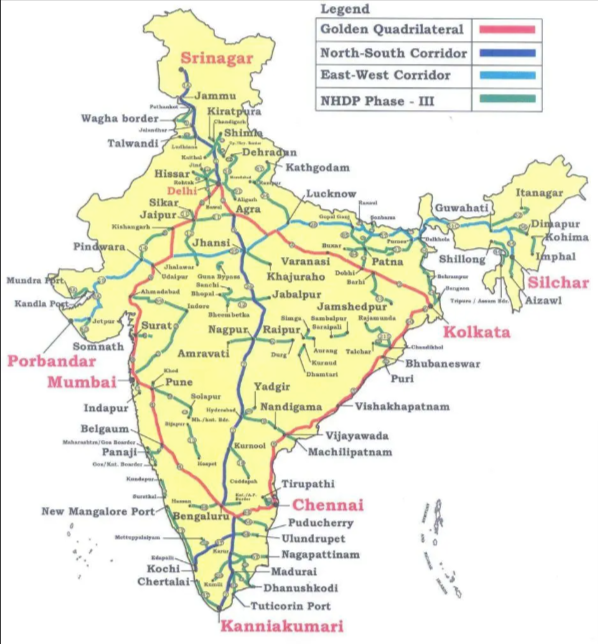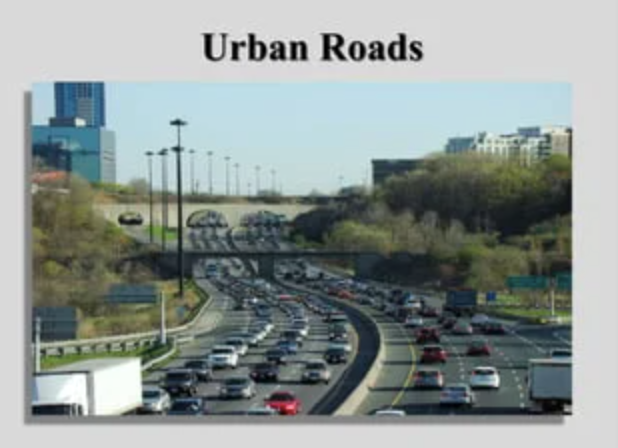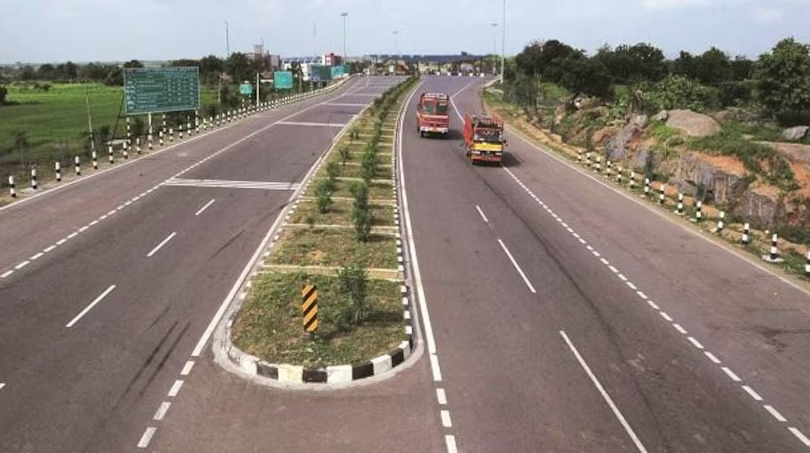If I explain it in simple language for you, India has the second-largest network of roads globally, it covers a massive distance of 63.71 lakh Kilometers. Road transport is the most important way for people and goods to move around in India. It’s the top choice for transportation to people, both in terms of the number of vehicles on the road and how much it helps the country make money. About 3.08% of India’s Gross Value Added (which is a way to measure the country’s overall economic output) comes from road transport. To explain more simply, I will tell you that, out of all the money that the transportation sector makes in India, roadways contribute the most.
India’s road infrastructure is categorized into six categories:
National highway :

- National Highways are the main roads in India, linking big cities and major industrial areas.
- It is the central government who is responsible for building and looking after these highways.
- Even though they make up only a small portion (2.06%) of all roads in India . They handle (40%) of Indian traffic.
- Having more National Highways means more trade between states, which helps the economy grow.
- Research shows that states with more National Highways tend to have higher incomes for their people.
- Right now, most National Highways are narrow, with just two lanes or less.
- This causes traffic jams and slows down the movement of goods.
- There’s a need to widen these highways and make them better to make transportation smoother and faster.
State Highways :

- State Highways are the roads within a state, connecting important centers of industry, trade, and commerce, as well as linking to National Highways.
- These roads, totaling 1.79 lakh kilometers, are important for facilitating transportation and economic activities within each state.
- District Roads, on the other hand, are roads that connect various parts of a district, including important industrial centers, marketplaces, and local railway stations.
- With a total length of 6.12 lakh kilometers, District Roads play an important role in enabling movement and connectivity within districts, supporting local economies and transportation needs.
Rural Roads :

- Rural Roads are the roads found in villages across India, totaling a vast length of 45 lakh kilometers.
- These roads are important for connecting rural areas to towns and cities, enabling transportation of goods, services, and people.
- Rural Roads come in two main types: Pucca (also known as metalled or paved roads) and Kutcha (also known as non-metalled or unpaved roads).
- Pucca roads are made with materials like concrete, asphalt, or bricks, providing a smooth and durable surface.
- Kutcha roads, on the other hand, are made of natural materials like gravel, soil, or stones and may not be as smooth or durable.
- Rural Roads make up a significant portion, about 70%, of all roads in India, highlighting their importance in connecting rural communities and facilitating economic activities.
Urban Roads :

- Urban Roads are the roads within cities and urban areas, totaling 5.41 lakh kilometers in length.
- These roads are crucial for facilitating transportation within cities, connecting residential areas, commercial centers, and industrial zones.
- Urban Roads play a vital role in enabling the movement of people and goods within urban areas, supporting economic activities and urban development.
Project Roads :

It refers to roads that are part of specific development projects, totaling 3.43 lakh kilometers.
- These roads are typically built as part of infrastructure development initiatives, such as building new highways, expressways, or connecting remote areas.
- Project Roads contribute to improving connectivity and accessibility in various regions, enhancing transportation networks and promoting economic growth and development.
Rate of Growth of Road Development in India :
- Between 1991 and 2019, the total length of roads in India increased at an average annual rate of 3.64%.This means that every year, on average, the length of roads grew by 3.64%.
- However, between 1951 and 1991, the growth rate was higher, at 4.50% per year.
- Despite the lower growth rate after 1991, the absolute increase in road length has been significant.
- In 1951, India had 4 lakh kilometers of roads, which increased to 23 lakh kilometers by 1991.
- By 2019, this figure further rose to 62 lakh kilometers.Therefore, in the last 28 years from 1991 to 2019, around 40 lakh kilometers of roads were added across the country.
Key Reasons for improvement in road construction (both quality and quantity) in the last 3 decades:
Delinking Road Development and Direct Employment:
Before 1991, road development projects in India often involved manual labor-intensive methods that aimed to create direct employment opportunities. For example, road construction projects would employ a large number of workers to manually lay down materials such as asphalt or gravel, dig ditches, and perform other tasks involved in building roads. These projects typically relied heavily on human labor, with minimal use of machinery or technology. Additionally, there was a focus on hiring local workers, especially in rural areas, to provide them with employment opportunities. As a result, the emphasis was more on generating jobs through road construction rather than prioritizing factors like efficiency, quality, or long-term sustainability of the infrastructure.
2. Creation of National Highway Authority of India (NHAI):
Before the establishment of NHAI (National Highways Authority of India) in 1995, the responsibility for developing and maintaining National Highways (NHs) rested primarily with the state governments. This means that each state government was responsible for managing the NHS within its jurisdiction, with funding typically provided by the central government. However, this decentralized approach often led to inconsistencies in the quality and maintenance of NHs across different states.
For example, consider two neighboring states, State A and State B. In State A, the government might prioritize funding and resources towards maintaining NHs due to their strategic importance for interstate trade and connectivity. As a result, the NHs in State A might be well-maintained and of high quality.
In contrast, State B might allocate fewer resources towards NH maintenance, leading to poor road conditions, frequent potholes, and inadequate signage on its NHs. This disparity in the quality of NHs could hinder transportation efficiency, economic development, and road safety, particularly for interstate travelers and cargo transportation.
With the establishment of NHAI in 1995, there was a centralized authority dedicated solely to the development, maintenance, and management of National Highways across India. This centralization helped streamline decision-making processes, ensure consistent standards of quality and maintenance for NHs nationwide, and allocate resources more efficiently based on strategic priorities. As a result, NHAI’s establishment led to an increased focus on enhancing the quality and efficiency of NHs throughout the country.
3. Creation of State-Level Road Development Corporations:
After NHAI was created, states realized they needed better ways to manage road development projects instead of relying on Public Works Departments (PWDs). Maharashtra took the lead by establishing the Maharashtra State Road Development Corporation Limited (MSRDC) in August 1996. This corporation was responsible for overseeing important road projects, like the Pune-Mumbai expressway. By having specialized agencies like MSRDC, states could manage road projects more efficiently. For example, MSRDC’s management of the expressway project ensured it was completed on time and to a high standard. This success showed other states that forming specialized agencies could lead to better road infrastructure development.
4. Bringing In PPP Partnership:
To bring in Public-Private Partnership (PPP) partnerships in road development, the government initially structured concession agreements that heavily favored the government’s interests. This approach resulted in limited participation from private players, who were attracted to only low-risk projects. However, to enhance the success of PPP initiatives, the government introduced new contracting models and asset monetization strategies. These include Build-Operate-Transfer (BOT) models, which involve private entities building and operating road projects for a certain period before transferring them back to the government. The Hybrid Annuity Model (HAM) combines elements of both EPC (Engineering, Procurement, and Construction) and BOT models, where the government pays the private developer in installments over the concession period. Additionally, the Toll Operate Transfer (TOT) model allows private entities to operate and collect tolls on existing roads for a specified period, after which ownership is transferred back to the government. These contracting models and asset monetization strategies have played a crucial role in attracting private investment and expertise into road development projects, thereby accelerating infrastructure development across the country.
5. Starting of NHDP :
Starting in 1998, one of the largest road development projects in India commenced, which remained the biggest until the launch of Bharatmala. This project had two major components: the Golden Quadrilateral and the North-South & East-West Corridors. The Golden Quadrilateral aimed to connect four major metropolitan cities of India – Delhi, Mumbai, Chennai, and Kolkata – through a network of high-quality expressways. This network formed a quadrilateral shape, hence the name. On the other hand, the North-South & East-West Corridors focused on connecting the northern and southern parts of India, as well as the eastern and western regions, through dedicated road corridors. These corridors were designed to improve connectivity between different states and regions, facilitate smoother movement of goods and people, and boost economic development across the country. Overall, these projects were significant milestones in India’s road infrastructure development, laying the groundwork for enhanced connectivity and economic growth.
6.Pradhan Mantri Gram Sadak Yojna :
- Pradhan Mantri Gram Sadak Yojna (PMGSY), launched during the Vajpayee regime, is the most successful rural road development project in India.
- Its success can be attributed to:
- Selection of villages for connectivity based on objective criteria: Villages were chosen for road connectivity based on specific, fair criteria, ensuring that areas with the greatest need received attention.
- Oversight from independent agencies, including the World Bank: Having independent agencies, such as the World Bank, oversee the project ensured transparency and accountability, helping to maintain high standards and effective implementation.
- Project management under the Ministry of Rural Development (MoRD) rather than the Ministry of Road Transport and Highways (MoRTH)
- The project under MoRD, which focuses on rural development, was better suited to address the unique needs and challenges of rural areas, ensuring a more targeted and effective approach to rural road development.
7.Viability Gap Funding (VGF):
Viability Gap Funding (VGF) was introduced by the government when there were few private partners willing to invest in the Golden Quadrilateral (GQ) project through Public-Private Partnerships (PPPs). The idea behind VGF was to reduce the risks involved for private investors by providing financial support. The government agreed to cover up to 40% of the project cost through VGF. This assurance encouraged more private companies to bid for the project because it lowered the financial risks for them. As a result, many projects, especially after the initial phase, were undertaken through PPPs, leading to increased private sector participation in the development of the Golden Quadrilateral.
8.increased focus on Expressways:
India has placed a greater emphasis on constructing expressways, which are roads designed for fast and smooth travel with controlled access. The first expressway, connecting Mumbai and Pune, opened in 2002. Although the construction of expressways initially progressed slowly, there has been significant momentum in the last decade. As of August 2023, India boasts approximately 5,000 kilometers of operational expressways, with an additional 9,000 kilometers under construction. This surge in expressway construction signifies the country’s commitment to enhancing transportation infrastructure and facilitating quicker, more efficient movement of people and goods. As expressways offer controlled access and higher speeds compared to conventional roads, they play a crucial role in improving connectivity, reducing travel times, and boosting economic development across different regions of India.
9. Creation of Focused Organizations:
- indian Highway Management Company Limited (IHMCL): This organization was established to implement electronic toll collection on highways. Instead of paying tolls with cash, electronic tolling allows vehicles to pay automatically using electronic tags, making the process faster and more efficient.
- National Highways & Infrastructure Development Corporation Limited (NHIDCL): NHIDCL focuses on developing roads in border states of India. These roads are crucial for improving connectivity in remote areas near India’s borders, which helps in enhancing security and promoting economic development in those regions.
- National Highways Logistic Management Limited (NHLM): This company, formed in 2020, is responsible for developing Multimodal Logistic Parks (MMLPs) and improving connectivity to ports. MMLPs are strategic locations where various modes of transportation (such as road, rail, and waterways) converge, making it easier to transfer goods between different modes of transport. Additionally, improving connectivity to ports helps in facilitating smoother movement of goods to and from ports, supporting trade and commerce.
10.Improvement in Road Making Technology:
As the National Highways Development Project (NHDP) was implemented, the process of importing road infrastructure equipment became simpler through an Open General License, which made it easier for the government to buy necessary materials from other countries. Additionally, a mechanism was put in place to encourage domestic manufacturing by transferring technology to local companies.
Electronic Toll Collection (ETC) was introduced to reduce the time spent at toll booths and waiting in queues. With ETC, vehicles can pay tolls electronically without needing to stop, which helps to speed up the process. However, this technology still has room to improve. In developed countries, ETC systems allow vehicles to pay tolls while traveling at full speed, without needing to slow down or stop. India aims to evolve its ETC technology to reach this level of efficiency, making toll payments even quicker and smoother for drivers.
Some key challenges which continue and need to be worked upon:
- Safety: Indian roads witness more than 1.5 lakh deaths annually, making them the deadliest globally. To address this, improvements in road engineering, raising driver awareness to discourage reckless driving, ensuring buffer lanes for turns, and providing adequate roadside parking are essential.
- Urban Roads: City roads often face heavy congestion, affecting first and last-mile connectivity for commuters. This congestion hampers smooth movement within cities and impacts overall transportation efficiency.
- Lane Kms vs Road Kms: With the construction of more multi-lane roads, it’s crucial to measure lane kilometers (kms) alongside road kilometers. This helps gauge not only the length of roads but also their capacity to accommodate traffic, providing insights for better infrastructure planning.
- Origin to Destination (OD) Data: Access to Origin to Destination (OD) data is vital for future road network planning and development. OD data helps identify traffic flow patterns, allowing authorities to optimize routes and plan infrastructure upgrades accordingly. Additionally, OD data plays a role in electronic toll collection (ETC) systems.
- Better Coordination with PPP Players: Improved coordination between Public-Private Partnership (PPP) players and authorities is necessary to avoid disputes and project delays. Delays caused by disagreements can inconvenience the public and hinder infrastructure development progress, highlighting the need for smoother collaboration between all stakeholders involved in road projects.
Facts that you should remember for prelims as well as for mains:
- India has the second largest road network globally, totaling 63.71 lakh kilometers.
- Road transport dominates India’s transportation sector, contributing 3.08% to the Gross Value Added (GVA).
- India’s road infrastructure comprises six categories: National Highways, State Highways, District Roads, Rural Roads, Urban Roads, and Project Roads.
- National Highways span 1.32 lakh kilometer and connect major cities and industrial areas, maintained by the central government.
- Pradhan Mantri Gram Sadak Yojna (PMGSY) is the most successful rural road development project, focusing on objective village connectivity criteria.
- Electronic Toll Collection (ETC) reduces toll collection time and waiting by enabling payments while driving.
- NHIDCL develops roads in border states, enhancing connectivity and security in remote areas.
- NHAI, IHMCL, and NHLM were established to streamline highway management, electronic tolling, and logistic park development, respectively.
- PPP models like BOT, HAM, and TOT facilitate private sector involvement in road infrastructure projects.
- Safety remains a significant challenge, with over 1.5 lakh road-related deaths annually in India.
- Urban roads face congestion issues, hindering first and last-mile connectivity for commuters.
- Measurement of lane alongside road kilometers is crucial for assessing road capacity accurately.
- Origin to Destination (OD) data plays a vital role in road network planning and electronic toll collection systems.
- Better coordination with PPP players is necessary to avoid project delays and disputes, ensuring smoother infrastructure development processes.